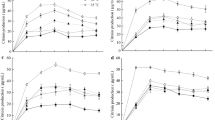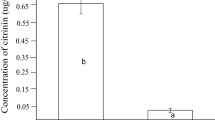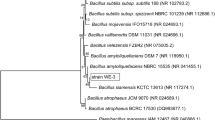Abstract
Citrinin is a common mycotoxin produced by different fungi. Although considerable endeavors have been made to increase citrinin output to meet the requirements of research and industrial needs, few methods are effective, owing to potential safety concerns and technical limitations. In this study, a blue fungus that produces a yellow pigment was isolated from Ziziphus jujuba. The strain was then identified as Penicillium citrinum and named HR-087. Preparative liquid chromatography was used to extract the yellow pigment. Both LC–MS and NMR assays showed that it was citrinin. To enhance the citrinin production of this strain, the culture medium was optimized through orthogonal experiments, as well as batch and fed-batch process. The final titer and productivity of citrinin reached 9.62 g/L and 0.1 g/(L × h), respectively. The high titer achieved indicates the possibility of large-scale production of high purity citrinin for low-cost supply for both academic and diagnostic analysis standard.




Similar content being viewed by others
Availability of data and materials
All data generated or analyzed during this study are included in this published article and its supplementary information file.
Code availability
Not applicable.
References
Moss MO. Mycotoxins of Aspergillus and other filamentous fungi. J Appl Bacteriol. 1989;67:S69–81.
Lanier C, Heutte N, Richard E, Bouchart V, Lebailly P, Garon D. Mycoflora and mycotoxin production in oilseed cakes during farm storage. J Agric Food Chem. 2009;57:1640–5.
de Oliveira Filho JW, Islam MT, Ali ES, Uddin SJ, de Oliveira Santos JV, de Alencar MV, Júnior AL, Paz MF, de Brito MD, de Sousa JM, Shaw S, Freire de Medeiros MdG, Mendes de Moura Dantas SM, Lins Rolim HM, Pinheiro Ferreira PM, Kamal MA, Pieczynska MD, Das N, Gupta VK, Mocan A, Aguiar dos Santos Andrade TdJ, Singh BN, Mishra SK, Atanasov AG, Melo-Cavalcante AAdC. A comprehensive review on biological properties of citrinin. Food Chem Toxicol. 2017;110:130–41.
Phillips RD, Hayes AW, Berndt WO. High-performance liquid chromatographic analysis of the mycotoxin citrinin and its application to biological fluids. J Chromatogr A. 1980;190:419–27.
Bovdisova I, Zbynovska K, Kalafova A, Capcarova M. Toxicological properties of mycotoxin citrinin. J Microbio Biotech Food Sci. 2016;5:10–3.
Chang C-H, Yu F-Y, Wang L-T, Lin Y-S, Liu B-H. Activation of ERK and JNK signaling pathways by mycotoxin citrinin in human cells. Toxicol Appl Pharm. 2009;237:281–7.
Nakajima Y, Iguchi H, Kamisuki S, Sugawara F, Furuichi T, Shinoda Y. Low doses of the mycotoxin citrinin protect cortical neurons against glutamate-induced excitotoxicity. J Toxicol Sci. 2016;41:311–9.
Kanpiengjai A, Mahawan R, Lumyong S, Khanongnuch C. A soil bacterium Rhizobium borbori and its potential for citrinin-degrading application. Ann Microbiol. 2016;66:807–16.
Han QQ, Yu LB, Guo YQ, Liu SQ. Toxic effects of citrinin on the male reproductive system in mice. Exp Toxicol Pathol. 2012;64:465–9.
Hetherington A, Raistrict H. Studies in the Biochemistry of Micro-organisms. Part XIV.—On the production and chemical constitution of a new yellow colouring mater, citrinin, produced from glucose by Penicillium. Phil Trans R Soc B. 1931;220B:269–95.
Hallas-Moller M, Nielsen KF, Frisvad JC. Production of the Fusarium Mycotoxin moniliformin by Penicillium melanoconidium. J Agric Food Chem. 2016;64:4505–10.
He Y, Cox RJ. The molecular steps of citrinin biosynthesis in fungi. Chem Sci. 2016;7:2119–27.
Blanc PJ, Loret MO, Goma G. Production of citrinin by various species of Monascus. Biotechnol Lett. 1995;17:291–4.
Orozco SFB, Kilikian BV. Effect of pH on citrinin and red pigments production by Monascus purpureus CCT3802. World J Microb Biot. 2008;24:263–8.
Hasan HAH, Issa AA. Influences of chemical fertilizers (in-vitro) on aflatoxin and citrinin synthesis by 2 strains of Aspergillus. Folia Microbol. 1993;38:456–8.
Shimizu T, Kinoshita H, Ishihara S, Sakai K, Nagai S, Nihira T. Polyketide synthase gene responsible for citrinin biosynthesis in Monascus purpureus. Appl Environ Microb. 2005;71:3453–7.
Liang B, Du XJ, Li P, Sun CC, Wang S. Investigation of citrinin and pigment biosynthesis mechanisms in Monascus purpureus by transcriptomic analysis. Front Microbiol. 2018;9:11.
Scott PM. Mycotoxin methodology. Food Addit Contam. 1995;12:395–403.
Shu PY, Lin CH. Simple and sensitive determination of citrinin in Monascus by GC-selected ion monitoring mass spectrometry. Anal Sci. 2002;18:283–7.
Meister U. New method of citrinin determination by HPLC after polyamide column clean-up. Eur Food Res Technol. 2004;218:394–9.
Appell M, Jackson MA, Wang LJC, Bosma WB. Determination of citrinin using molecularly imprinted solid phase extraction purification, HPLC separation, and fluorescence detection. J Liq Chromatogr R T. 2015;38:1815–9.
Abramson D, Usleber E, Martlbauer E. Determination of citrinin in barley by indirect and direct enzyme immunoassay. J Aoac Int. 1996;79:1325–9.
Bowers E, Hellmich R, Munkvold G. Comparison of fumonisin contamination using HPLC and ELISA methods in Bt and near-isogenic maize hybrids infested with European corn borer or western bean cutworm. J Agric Food Chem. 2014;62:6463–72.
Franco CM, Fente CA, Vazquez B, Cepeda A, Lallaoui L, Prognon P, Mahuzier G. Simple and sensitive high-performance liquid chromatography-fluorescence method for the determination of citrinin application to the analysis of fungal cultures and cheese extracts. J Chromatogr A. 1996;723:69–75.
Hou F, Mu T, Ma M, Blecker C. Optimization of processing technology using response surface methodology and physicochemical properties of roasted sweet potato. Food Chem. 2019;278:136–43.
Bodai Z, Szabo BS, Novak M, Hamori S, Nyiri Z, Rikker T, Eke Z. Analysis of potential migrants from plastic materials in milk by liquid chromatography-mass spectrometry with liquid-liquid extraction and low-temperature purification. J Agric Food Chem. 2014;62:10028–37.
Hong JL, Wu L, Lu JQ, Zhou WB, Cao YJ, Lv WL, Liu B, Rao PF, Ni L, Lv XC. Comparative transcriptomic analysis reveals the regulatory effects of inorganic nitrogen on the biosynthesis of Monascus pigments and citrinin. RSC Adv. 2020;10:5268–82.
Brakhage AA. Regulation of fungal secondary metabolism. Nat Rev Microbiol. 2013;11:21–32.
Blin K, Shaw S, Steinke K, Villebro R, Ziemert N, Lee SY, Medema MH, Weber T. antiSMASH 5.0: updates to the secondary metabolite genome mining pipeline. Nucleic Acids Res. 2019;47:W81–7.
Weber T, Rausch C, Lopez P, Hoof I, Gaykova V, Huson DH, Wohlleben W. CLUSEAN: a computer-based framework for the automated analysis of bacterial secondary metabolite biosynthetic gene clusters. J Biotechnol. 2009;140:13–7.
Skinnider MA, Merwin NJ, Johnston CW, Magarvey NA. PRISM 3: expanded prediction of natural product chemical structures from microbial genomes. Nucleic Acids Res. 2017;45:W49–54.
Saldaña-Mendoza SA, Ascacio-Valdés JA, Palacios-Ponce AS, Contreras-Esquivel JC, Rodríguez-Herrera R, Ruiz HA, Martínez-Hernandez JL, Sugathan S, Aguilar CN. Use of wastes from the tea and coffee industries for the production of cellulases using fungi isolated from the Western Ghats of India. Syst Microbiol Biomanuf. 2021;1:33–41.
Bergmann S, Schumann J, Scherlach K, Lange C, Brakhage AA, Hertweck C. Genomics-driven discovery of PKS-NRPS hybrid metabolites from Aspergillus nidulans. Nat Chem Biol. 2007;3:213–7.
Bergmann S, Funk AN, Scherlach K, Schroeckh V, Shelest E, Horn U, Hertweck C, Brakhage AA. Activation of a silent fungal polyketide biosynthesis pathway through regulatory cross talk with a cryptic nonribosomal peptide synthetase gene cluster. Appl Environ Microbiol. 2010;76:8143–9.
Kale SP, Milde L, Trapp MK, Frisvad JC, Keller NP, Bok JW. Requirement of LaeA for secondary metabolism and sclerotial production in Aspergillus flavus. Fungal Genet Biol. 2008;45:1422–9.
Jackson LK, Ciegler A. Production and analysis of citrinin in corn. Appl Environ Microbiol. 1978;36:408–11.
Abramson D, Lombaert G, Clear RM, Sholberg P, Trelka R, Rosin E. Production of patulin and citrinin by Penicillium expansum from British Columbia (Canada) apples. Mycotoxin Res. 2009;25:85–8.
Krishnamoorthy J, Mathew A, Kooloth-Valappil P, Adarsh VP, Puthiyamadam A, Pandey A, Sukumaran RK. Ethanol production by a filamentous fungal strain Byssochlamys fulva AM130 under alternating aerobic and oxygen-limited conditions. Syst Microbiol Biomanuf. 2021;1:111–21.
Wang CL, Yang H, Chen MH, Wang YR, Li FJ, Luo C, Zhao SY, He D. Real-time quantitative analysis of the influence of blue light on citrinin biosynthetic gene cluster expression in Monascus. Biotechnol Lett. 2012;34:1745–8.
Liang B, Du XJ, Li P, Guo H, Sun CC, Gao JX, Wang S. Orf6 gene encoded glyoxalase involved in mycotoxin citrinin biosynthesis in Monascus purpureus YY-1. Appl Microbiol Biot. 2017;101:7281–92.
Olsen M, Lindqvist R, Bakeeva A, Leong SLL, Sulyok M. Distribution of mycotoxins produced by Penicillium spp. inoculated in apple jam and creme fraiche during chilled storage. Int J Food Microbiol. 2019;292:13–20.
Ostry V, Malir F, Cumova M, Kyrova V, Toman J, Grosse Y, Pospichalova M, Ruprich J. Investigation of patulin and citrinin in grape must and wine from grapes naturally contaminated by strains of Penicillium expansum. Food Chem Toxicol. 2018;118:805–11.
Lin YL, Wang TH, Lee MH, Su NW. Biologically active components and nutraceuticals in the Monascus-fermented rice: a review. Appl Microbiol Biot. 2008;77:965–73.
Pang C, Yin X, Zhang G, Liu S, Zhou J, Li J, Du G. Current progress and prospects of enzyme technologies in future foods. Syst Microbiol Biomanuf. 2021;1:24–32.
Acknowledgements
Not applicable.
Funding
This work was supported by the National Key Research and Development Program of China (2018YFC1604102) and the National Science Fund for Excellent Young Scholars (21822806).
Author information
Authors and Affiliations
Contributions
HZ carried out the experiments and drafted the manuscript. SG assisted in optimization of biosynthesis reaction conditions. ZD collected the Ziziphus jujuba and purified the strain. WZ and JZ participated in designing the study and writing the manuscript. All authors read and approved the final manuscript.
Corresponding author
Ethics declarations
Conflict of interest
The authors declare that they have no competing interests.
Ethics approval
Not applicable.
Consent for publication
Not applicable.
Supplementary Information
Below is the link to the electronic supplementary material.
Rights and permissions
About this article
Cite this article
Zhou, H., Gao, S., Zeng, W. et al. Optimization of citrinin production by endophytic Penicillium citrinum isolated from Ziziphus jujuba. Syst Microbiol and Biomanuf 2, 634–642 (2022). https://doi.org/10.1007/s43393-022-00087-7
Received:
Revised:
Accepted:
Published:
Issue Date:
DOI: https://doi.org/10.1007/s43393-022-00087-7




